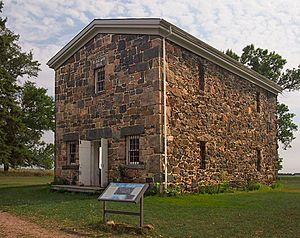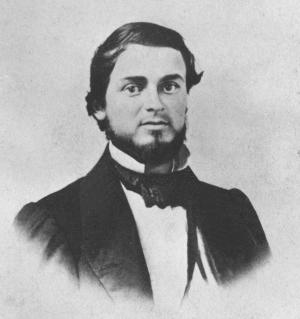Attack at the Lower Sioux Agency facts for kids
Quick facts for kids Attack at the Lower Sioux Agency |
|||||||
|---|---|---|---|---|---|---|---|
| Part of the Dakota War of 1862 | |||||||
 The stone warehouse built in 1861, the only original building remaining on the Lower Agency site |
|||||||
|
|||||||
| Belligerents | |||||||
| Santee Sioux | |||||||
| Commanders and leaders | |||||||
| Chief Little Crow | |||||||
| Casualties and losses | |||||||
| 20 killed 10 captured 47 escaped |
None noted | ||||||
The Attack at the Lower Sioux Agency was the first major event of the Dakota War of 1862. It happened in Minnesota on August 18, 1862. Dakota leader Little Crow led this attack. Thirteen settlers died at the agency. Seven more were killed while trying to escape to Fort Ridgely.
Before the attack, people were very tense. Many eastern Dakota people were angry. Traders had refused to give them supplies during a summer when food was scarce. Also, the U.S. Indian agents had not given them money and goods they were promised by treaty. The first attack on the Lower Sioux Agency focused on the four trading stores. Dakota people took food, clothing, guns, and ammunition from these stores.
After this attack, violence spread quickly. Farms and settlements in nearby counties were affected. About 200 settlers were killed. Another 200 were taken captive. Some settlers were saved because Dakota people warned them to leave.
Contents
Why the Attack Happened
Tensions were already high after an event in Acton Township, Minnesota on August 17. Four young Wahpeton Dakota hunters had killed five white settlers. Usually, only the people who committed such acts were punished. But this time, some Dakota leaders saw a chance for a bigger uprising.
Leaders like Cut Nose and Red Middle Voice knew the U.S. government had not given the Dakota their promised payments and food. This was during a very hard summer when many eastern Dakota were starving. They also knew that the Americans were busy fighting their own Civil War. This meant the U.S. might have fewer soldiers available.
In the middle of the night, Red Middle Voice and Chief Shakopee III met with Little Crow. Little Crow was an important leader. His support was needed to start a war. At first, Little Crow thought fighting the Americans was useless. But he eventually agreed to lead the uprising. He ordered an attack on the Lower Sioux Agency for the next morning.
On August 18, some traders were away from the Lower Sioux Agency. This left others in charge of their stores.
Who Was Involved
Early in the morning, a group of Dakota soldiers marched toward the Lower Sioux Agency. This place was also called the Redwood Agency. Many of these soldiers were from the villages of Red Middle Voice and Shakopee. Others from the villages of Mankato, Big Eagle, and Little Crow joined them.
Not all Dakota leaders agreed with the war. Chief Wabasha III was against it and refused to lead his group. Some Dakota men and women even warned their relatives and friends in the area to flee.
Many leaders found it hard to control their groups. Young warriors sometimes acted on their own. Historians suggest that a group called the akicita (soldiers' lodge) from Shakopee's village led the attack. They seemed to target people who had refused to help the Dakota with food or supplies. One young soldier, Tawasuota, was among the first to attack.
The Attack Begins
On the morning of August 18, a large group of Dakota soldiers surrounded the Lower Sioux Agency. This settlement included homes for government workers, trading stores, and other buildings. The soldiers split into small groups. They surrounded the four trade houses at the agency. Then, they fired their weapons all at once.

Here are some of the people killed in the first attack:
- James W. Lynd was a former state senator. He worked at Myrick's trading store. Lynd had a Dakota wife and two children. He was the first to be killed. A soldier named Tawasuota attacked him, upset about not getting supplies.
- Andrew Myrick was a trader who had refused to give supplies to the Dakota when they were very hungry. He was shot twice. Myrick tried to escape through a window but was killed before he could reach safety.
- George W. Divoll and "old Fritz" also worked at Myrick's store. Both were shot behind the counter.
- Francois LaBathe was a trader with French and Dakota family. He was killed in his own store.
- Joseph E. Belland and Antoine Young were clerks at William Forbes's store.
- Patrick McClellan was a clerk at Louis Robert's store.
- Alexis Dubuque was a clerk for either Forbes or Myrick.
Three government workers were killed when they tried to stop the Dakota soldiers from taking horses. These included A. H. Wagner, John Lamb, and Lathrop Dickinson. Philander Prescott, an older fur trader who had lived with the Dakota for forty years, was killed while running toward his house.
In total, thirteen people were killed at the Lower Agency.
Escape and Pursuit
Many Dakota soldiers then took supplies from the trading stores. They took flour, pork, clothing, guns, and ammunition. The attack paused long enough for about fifty people to escape. They hid in the thickets below the bluff. From there, these civilians headed toward Fort Ridgely, which was fourteen miles away.
Some people were helped across the river by the ferryman. Others ran away on foot. Reverend Samuel D. Hinman was one of the last to cross by ferry. He fled in a buggy after seeing Little Crow. Hinman asked Little Crow what was happening. When Little Crow gave him a fierce stare, Hinman knew he was in danger.
However, seven more settlers were caught and killed while trying to escape. This included Dr. Philander P. Humphrey, the agency doctor, his sick wife, and two of their children. They were killed after crossing the river and going four miles. Dr. Humphrey had stopped to let his wife rest. Only his twelve-year-old son survived. He had been sent to get water for his mother and eventually reached the fort.
The life of George Spencer, a clerk at William Forbes's store, was saved. His friend Wakinyantawa, a Dakota soldier, protected him. Spencer had been wounded but was taken captive for the rest of the war. William Bouratt, who was part-Dakota, was allowed to escape.
What Happened Next
About 85 people lived at the Lower Sioux Agency when the attacks happened. Historian Marion P. Satterlee says 13 people were killed at the agency. Another seven were killed while trying to escape. About ten people were captured, and 47 escaped. After the buildings at the Lower Agency were emptied, they were set on fire and burned down.
The ferryman who helped people escape was also killed. A marker says his name was "Charlie Martel," but other accounts suggest his name was Jacob Mauley or Hubert Millier. As the Dakota attackers started crossing the river, Olivier Martell, the owner of the ferry, rode his horse toward Fort Ridgely.
More Attacks
As people who escaped the attack arrived at Fort Ridgely, Captain John S. Marsh left the fort. He led 47 men toward the Lower Sioux Agency to help. Marsh and his men were ambushed in what is now called the Battle of Redwood Ferry.
The violence grew worse. Dakota soldiers attacked isolated homes in Brown and Renville counties. They killed about 200 settlers. They also took about 200 women, children, and part-Dakota civilians as hostages. Historians say that the actions of the Dakota soldiers showed how much confusion there was. No one seemed to be fully in charge.
|



